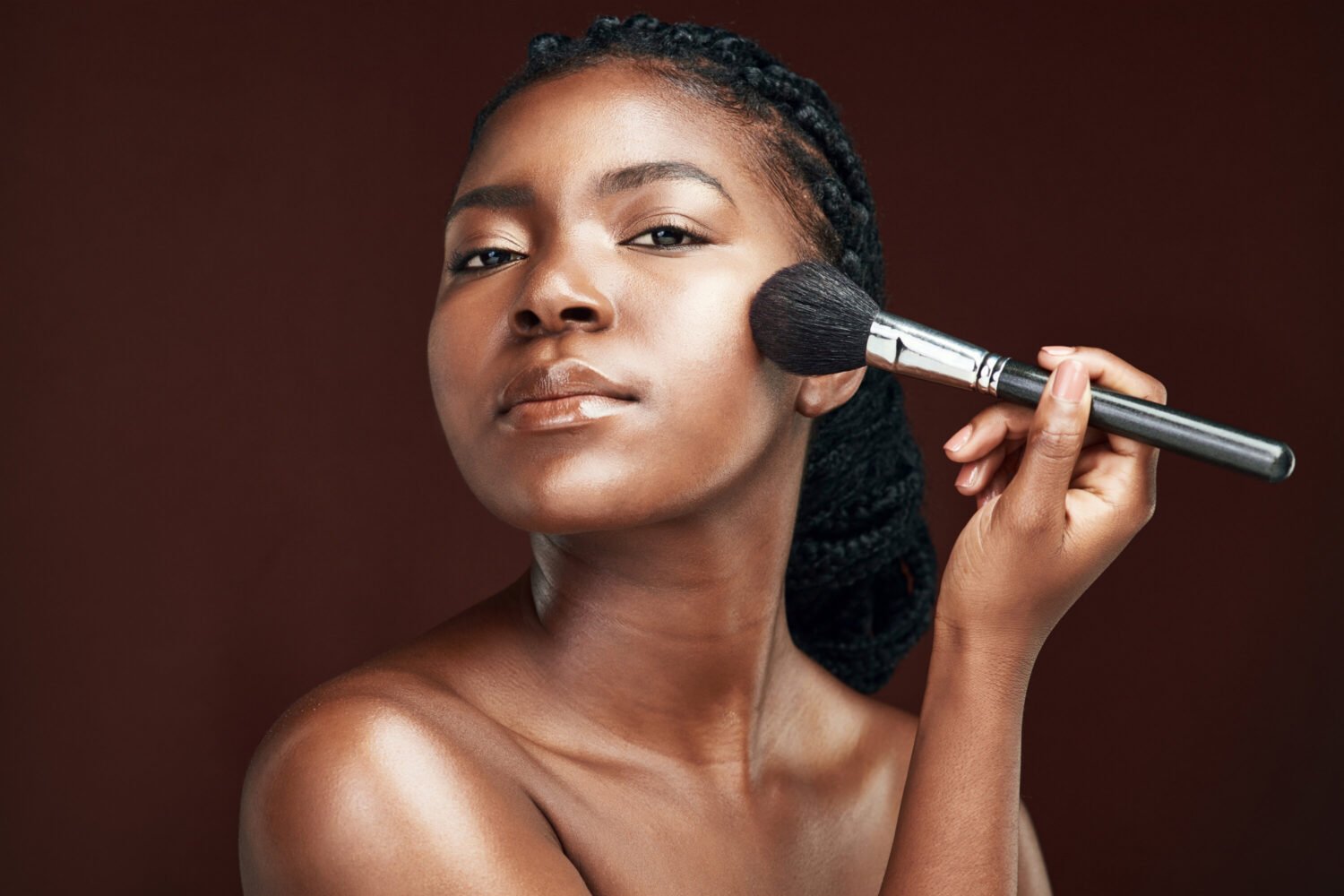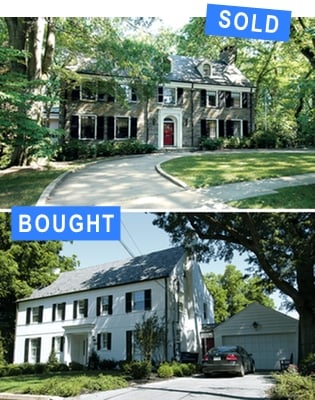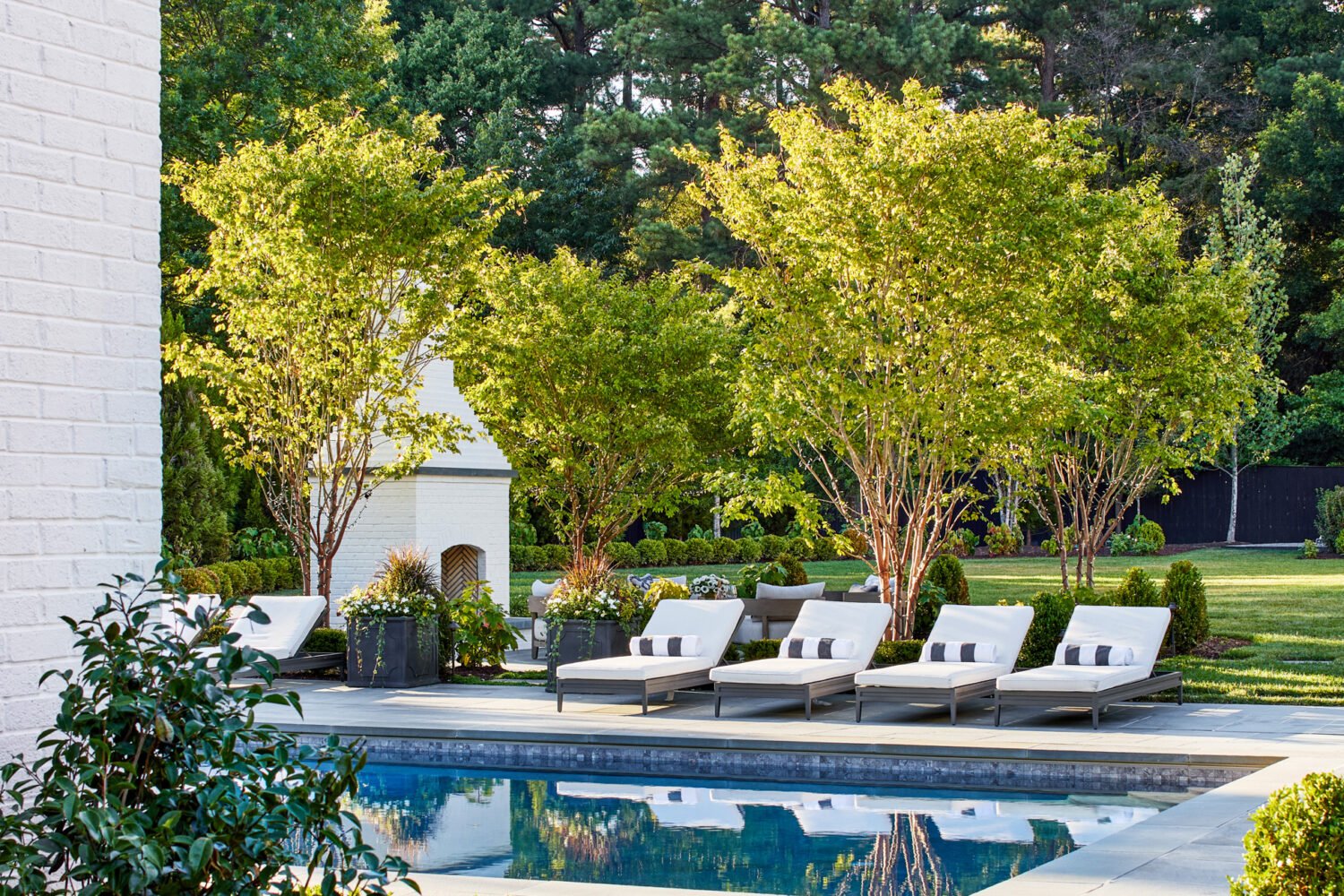Sheri Rhodes and her husband, John, have lived in eight different houses across Northern Virginia, Texas, Montana, Toronto, and Bangkok. “What was ubiquitous,” she says, “was the grassy lawn.”
In 2021, the couple started building home number eight on a five-acre lot in Great Falls. After decades of grassy suburban living, Rhodes and her husband, now both 58 and retired, are no longer interested in the maintenance a classic lawn requires. So they worked with landscape architects Joe Richardson and Jordan Clough of DC’s Richardson & Associates to design a space that enhanced, rather than imposed conformity on, the natural environment.
“What we’re trying to accomplish is not just a pretty lawn or yard,” says Rhodes. “You’re trying to provide some diversity of plant life, which then provides diversity of insect life, which then provides diversity of other wildlife.”
In just two years, Rhodes has gone from a lifetime of suburban lawns to acres of anything but. She estimates that only 10 percent of her property might be considered landscaped. The rest contains an orchard, beehives, 165 new trees, and swaths of meadow-like space untouched by its new residents, who are sitting back to watch it grow. “We will, one day, have a forest,” she says.
Rhodes is part of a growing movement of US homeowners questioning the supremacy of the all-grass yard, aided by an increasing number of pollinator-friendly state and local laws. Lawns still dominate—the Lower 48 contains 40 million acres of lawn, making turf grass, by area, the biggest irrigated crop in the country. But gardens have been gaining momentum: In 2020, the National Wildlife Federation reported a 50-percent increase in registered Certified Wildlife Habitat gardens and saw a fivefold jump in the number of people searching wildlife gardening tips online. And as ecologists will tell you, lawns do absolutely nothing for the environment—in fact, they cause significant harm by sucking up valuable resources and requiring pesticides and fuel-operated mowers.
Landscape architects say this trend is playing out around our area, too, as more clients voice interest in the no-grass life—or at least are curious about alternatives. Clough can typically tell who might be game just by looking at their house’s aesthetic. “If somebody has a mock Versailles or a huge neo-Colonial, I know that’s going to be a much more difficult conversation than someone who has bamboo flooring and solar panels,” he says. If clients are open to the conversation, he can usually inspire them to consider shrinking their front lawn or try something more experimental in their backyard.
“How we treat the land is a reflection of society’s values,” says Clough. “I think we’re going through a big transition right now where people are scrutinizing a lot of these assumptions.”
The History of Green Lawns
The idyllic expanse of green that homeowners have long associated with success, status, and our nation’s namesake dream is, like so many supposedly all-American innovations, not actually American.
The lawn as we know it hails from 18th-century England, where estates boasted vast fields of manicured grass. “These big landowners would show off their wealth by saying, ‘We don’t have to grow crops or have livestock. We’re so rich we can have this luxury,’ ” says Tamara Belt, owner of Hawthorne Garden Design. Colonists imported the ideal to the United States—one of its most famous early adopters was Thomas Jefferson, who mimicked the European aesthetic at his Monticello estate. George Washington also had a bowling green at Mount Vernon.
In the late 1940s, the Levittown suburbs on Long Island—those affordable, postwar homes of individuality-crushing and Cheever-inspiring fame—set a new model for middle-class life, which included a well-kept stretch of grass. Families in the first Levittown were required to mow their yards weekly. “People decide, ‘For my home to look as nice and neat and orderly as possible, I need to have this lawn,’ ” says Ryan Moody of Moody Graham Landscape Architecture. “There’s this cultural suggestion that you’re taking care of something.”
And, like the white-picket fence, the lawn took on an added significance. “There’s this idea that, as we move to the suburbs, the lawn is the everyman’s leisure,” says Clough. “It’s signifying that we’ve all moved up.”
But landscape architects and other experts are now questioning the lawn’s centrality in American life. For starters, most of the grass used—like the whole idea of having it in the first place—isn’t native to North America. Even so-called Kentucky bluegrass is from Europe.
These lawns demand tons of labor (it’s worth noting that grass-popularizers Jefferson and Washington weren’t out there mowing it themselves) and resources. By NASA’s calculation, it would take 200 gallons of drinking-caliber water per person per day to maintain all of America’s lawns. Pesticides and lawn-mower emissions harm both human and environmental health. In return, these yards contribute basically nothing, says Moody, who designates their “ecological functions” as “pretty limited.”
The science is in—but culture lags behind. “It takes a lot longer for people’s aesthetic tastes to change,” says Clough. Homebuyers who’ve just poured their savings into a new house can be hesitant to take big risks, especially with the part of their home everybody sees. And homeowners’ associations can take umbrage at such decisions: As reported by the New York Times, a couple in Columbia sued their HOA a few years ago over its efforts to dismantle their wildlife garden, ultimately paving the way for a 2021 Maryland law curtailing the power such groups have over these types of yards. While Belt says homeowners’ associations haven’t presented any official obstacles to her work, she acknowledges “a social pressure” to stick to the conventional path, out of insecurity about “how your house looks compared to the neighbors.”
And many Americans have grown up with a vision about what their home should look like. Some are even attached to the labor that aesthetic requires. “Lawn maintenance has been so woven into our culture that people don’t take a second guess at it,” says Clough. “[They’re] like, ‘This is what I do on a Saturday.’ ”
This has traditionally been true for men, who are stereotypically the ones with the white-knuckle grip on mowers. It’s all very 1950s, the whole thing: the wife in the kitchen, apron-clad and domestically occupied; the husband out front, with a pipe in his mouth and sweat on his brow, as he tends to his manicured domain. But, says Moody, men can connect with natural areas in other ways they perhaps haven’t explored because they’ve been coded as feminine, such as gardening: “We’ve been trained to think it’s got to be mowing the lawn.”
Parents may also hesitate to forgo what they assume is the best space for children to play. But the interest of a diverse yard can actually be a draw. “I’ve seen with my own eyes: Kids become more engaged,” says Clough. “There’s hiding places, there’s seasonal interest, there’s stuff to look at. There’s bugs and butterflies.”
A client of Belt’s, Mary Shepard, 68, was delighted to discover that when she and her husband, 72, transformed their Chevy Chase yard into what they call their “front garden,” the space—centered around a huge magnolia tree, with a path winding through river rocks and plants—thoroughly charmed their youngest neighbors: One kid chased an errant tennis ball into what he called “the jungle.”
Shepard figures she and her husband are the “eccentric retirees” of their mostly grass-lawned neighborhood. But she hasn’t received blowback yet. They’ve won over some four-legged fans as well. “We have several local foxes,” she says. “They seem to like it, too.”
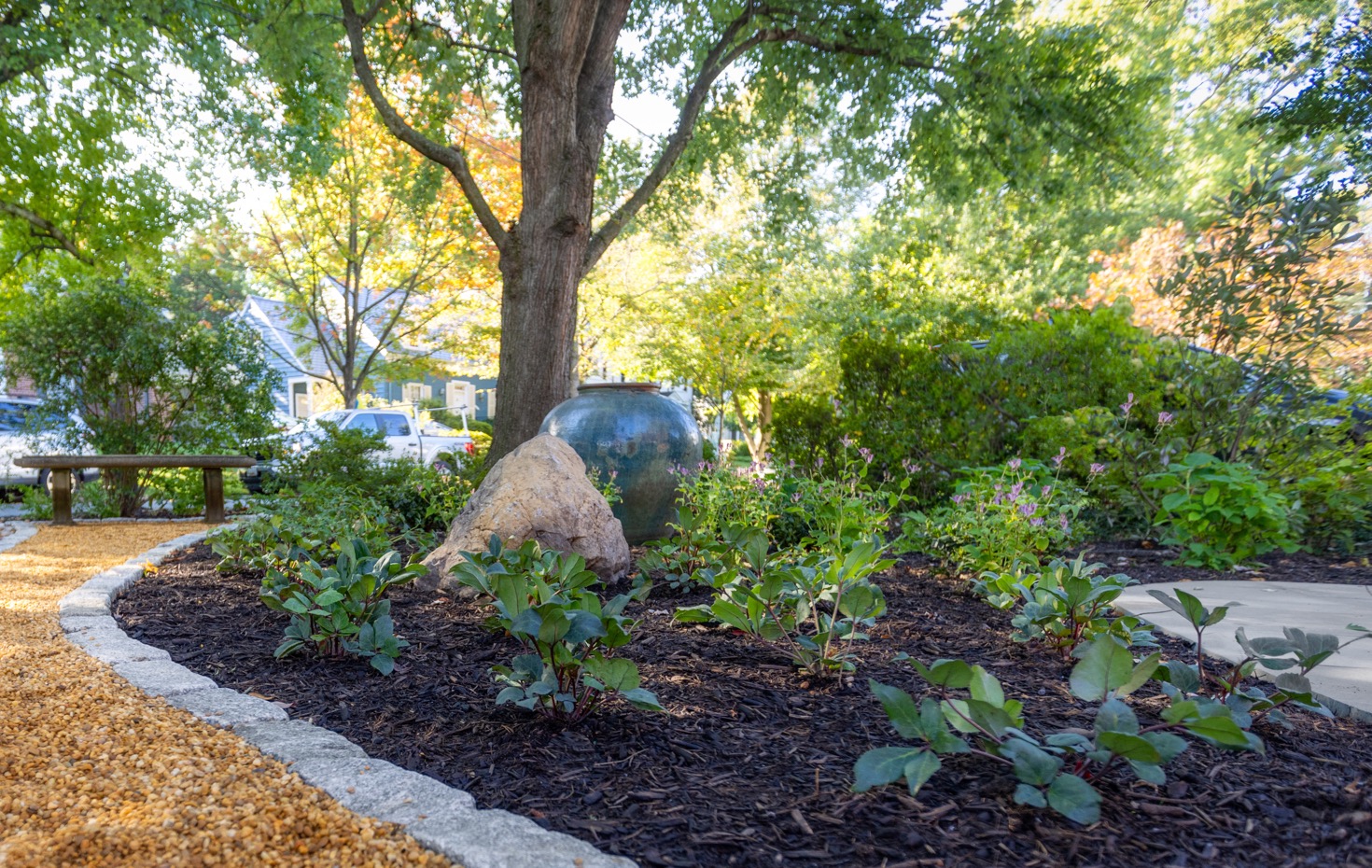
A Deeper Connection with Nature
Changing your lawn is as much about altering your mindset as it is about swapping out grass for native plants. “We’ve trained ourselves to have these certain expectations,” says Lisa Caprioglio, a landscape designer and owner of Aldertree Garden. “I think we can retrain ourselves to think of different things as beautiful.”
It’s also about having a more expansive definition of who your neighbors are: not just the people next door but the species that belong in the earth where your house sits, and the bugs and birds and pollinators that pass through. “It’s less of a human-centric perspective,” says Moody.
Also important: learning to relinquish control. The lawn is an imposition of sameness on a space meant to experience seasons. “Our yards have become this static green,” says Caprioglio. “It looks the same in December as it does in July.” Giving up grass means accepting that efforts at manhandling nature into submission are expensive, futile, and likely misguided. A yard full of native plants gives its occupants “a connection to the seasons,” Caprioglio explains. “Some things bloom now, some things bloom later. It’s not just a green blob.”
Out in Great Falls, Rhodes is realizing “there’s not so much of an end result. It’s a process, and it takes time.” But she finds the practice an enriching one, with “a psychological benefit” beyond what she anticipated: “The more we learn, the more we see that, ecologically, what does make sense is to follow nature’s lead.”
The Secret to Biodiverse Lawns
Interested in the no-mow life? Here are tips to help your vision take root.
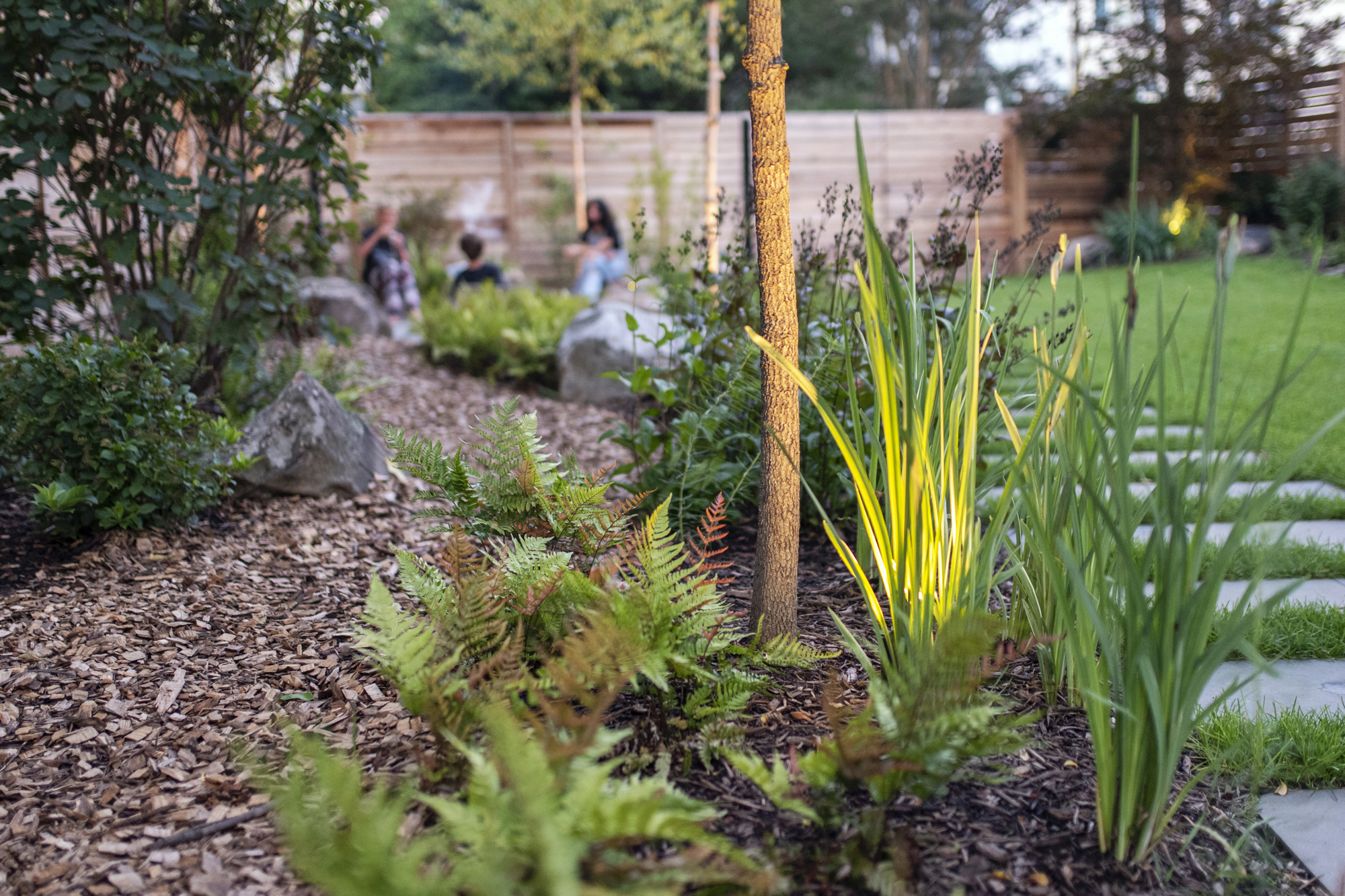
Be Prepared for a Rough Patch
If you’re reverting lawn back to a blank slate of soil before adding native elements, “you’re looking at a full season—a 12-month cycle—of looking awkward,” says landscape architect Jordan Clough. Think of it as puberty for your lawn: It will pass. “After that first year, your maintenance basically goes down to nothing.”
Opt for a Variety Show
“Diversity is your friend,” says Clough. Even pros can’t fully predict which plants will thrive in your yard, so invest in an assortment. “That’s how you really ensure that you get something nice and robust.”
Design With Intention
Consider the use of the space as well as ways to add visual contrast: Provide places to walk, such as a stone path, and create layers with tall trees like oaks; smaller trees like dogwoods; shrubs; and then a base layer of ferns, grasses, or native perennials, says landscape designer Lisa Caprioglio. The result will be vibrant without “looking random.”
Think Beyond Flowers
Lots of plants bloom only for a couple of weeks, max, says landscape architect Tamara Belt. “Most of the time, you’re looking at the foliage of whatever plant you purchase.” So make sure you really like those leaves.
Don’t Forget About Trees
“One oak tree is worth lots of flowers, in terms of supporting the ecosystem,” says Caprioglio. She favors oaks—they’re great for biodiversity and native to the area. An oak may not seem as glam as a butterfly-attracting flower, but “that’s where caterpillars are!”
Try Local Favorites
Belt’s top tree recommendation is the sweetbay magnolia. It keeps its leaves until December, or through spring if winter is mild. For shrubs, she loves summersweet, a.k.a. sweet pepperbush: “It’s native to swampy woodlands and shady areas, but it can also take sun, and it has beautiful blooms.” For perennials, try echinacea—it has pretty pinkishpurple petals, plus migrating birds love the seeds—and solidago, or goldenrod. In shade, go for heuchera, or coral bells, whose leaves range in color from “spring green to purple to chartreuse.”
Start Small
“It doesn’t have to be all-or-nothing,” says Caprioglio. Clough recommends starting with the backyard if you’re anxious about the front. Plant trees and a garden, but save some green space for your kid. Belt’s advice: “Try a section, see how it goes, see what plants you like, [and] you can keep extending plants. It’s incremental change. But every square inch you take out is better for biodiversity.”
This article appears in the August 2023 issue of Washingtonian.


